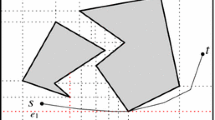Abstract
We investigate the \(L_1\) geodesic farthest neighbors in a simple polygon P, and address several fundamental problems related to farthest neighbors. Given a subset \(S \subseteq P\), an \(L_1\) geodesic farthest neighbor of \(p \in P\) from S is one that maximizes the length of \(L_1\) shortest path from p in P. Our list of problems include: computing the diameter, radius, center, farthest-neighbor Voronoi diagram, and two-center of S under the \(L_1\) geodesic distance. We show that all these problems can be solved in linear or near-linear time based on our new observations on farthest neighbors and extreme points. Among them, the key observation shows that there are at most four extreme points of any compact subset \(S \subseteq P\) with respect to the \(L_1\) geodesic distance after removing redundancy.








Similar content being viewed by others
Notes
If \(\pi \) is polygonal, then \(|\pi |\) is the sum of the \(L_1\) distances between its consecutive vertices. In general, \(|\pi |\) is the limit of the sequence \(|\pi _1|, |\pi _2|, \ldots \) such that each \(\pi _i\) for \(i=1, 2, \ldots \) is a polygonal path and the sequence \(\pi _1, \pi _2, \ldots \) converges to \(\pi \).
References
Ahn, H.K., Barba, L., Bose, P., De Carufel, J.-L., Korman, M., Oh, E.: A linear-time algorithm for the geodesic center of a simple polygon. Discrete Comput. Geom. 56(4), 836–859 (2016)
Aronov, B., Fortune, S., Wilfong, G.: The furthest-site geodesic Voronoĭ diagram. Discrete Comput. Geom. 9(3), 217–255 (1993)
Bae, S.W., Korman, M., Okamoto, Y., Wang, H.: Computing the $L_1$ geodesic diameter and center of a simple polygon in linear time. Comput. Geom. 48(6), 495–505 (2015)
Barba, L.: Optimal algorithm for geodesic farthest-point Voronoi diagrams. In: Proceedings of the 35th Symposium on Computational Geometry (SoCG 2019). LIPIcs (2019)
Chan, T.M.: More planar two-center algorithms. Comput. Geom. 13(3), 189–198 (1999)
Drezner, Z.: On the rectangular $p$-center problem. Nav. Res. Logist. 34(2), 229–234 (1987)
Guibas, L.J., Hershberger, J.: Optimal shortest path queries in a simple polygon. J. Comput. Syst. Sci. 39(2), 126–152 (1989)
Guibas, L.J., Hershberger, J., Leven, D., Sharir, M., Tarjan, R.: Linear time algorithms for visibility and shortest path problems inside triangulated simple polygons. Algorithmica 2(2), 209–233 (1987)
Hershberger, J., Snoeyink, J.: Computing minimum length paths of a given homotopy class. Comput. Geom. 4(2), 63–97 (1994)
Hershberger, J., Suri, S.: Matrix searching with the shortest path metric. SIAM J. Comput. 26(6), 1612–1634 (1997)
Megiddo, N.: Linear-time algorithms for linear programming in ${ R}^3$ and related problems. SIAM J. Comput. 12(4), 759–776 (1983)
Oh, E., Barba, L., Ahn, H.K.: The farthest-point geodesic Voronoi diagram of points on the boundary of a simple polygon. In: Fekete, S., Lubiw, A. (eds.). Proceedings of the 32nd Symposium on Computational Geometry (SoCG 2016), vol. 51, pp. 56:1–56:15. LIPIcs, Leibniz International Proceedings in Informatics, Schloss Dagstuhl. Leibniz-Zentrum für Informatik, Wadern (2016)
Oh, E., Bae, S.W., Ahn, H.-K.: Computing a geodesic two-center of points in a simple polygon. Comput. Geom. 82, 45–59 (2019)
Oh, E., De Carufel, J.L., Ahn, H.K.: The 2-center problem in a simple polygon. Comput. Geom. 74, 21–37 (2018)
Preparata, F.P., Shamos, M.I.: Computational Geometry: An Introduction. Texts and Monographs in Computer Science. Springer, New York (1985)
Toussaint, G.T.: Computing geodesic properties inside a simple polygon. Revue D’Intelligence Artificielle 3, 9–42 (1989)
Author information
Authors and Affiliations
Corresponding author
Additional information
Editor in Charge: Kenneth Clarkson
Publisher's Note
Springer Nature remains neutral with regard to jurisdictional claims in published maps and institutional affiliations.
This research was supported by Basic Science Research Program through the National Research Foundation of Korea (NRF) funded by the Ministry of Education (2015R1D1A1A01057220 and 2018R1D1A1B07042755). A preliminary version of this work was presented at ISAAC 2016.
Rights and permissions
About this article
Cite this article
Bae, S.W. \(L_1\) Geodesic Farthest Neighbors in a Simple Polygon and Related Problems. Discrete Comput Geom 62, 743–774 (2019). https://doi.org/10.1007/s00454-019-00110-0
Received:
Revised:
Accepted:
Published:
Issue Date:
DOI: https://doi.org/10.1007/s00454-019-00110-0




